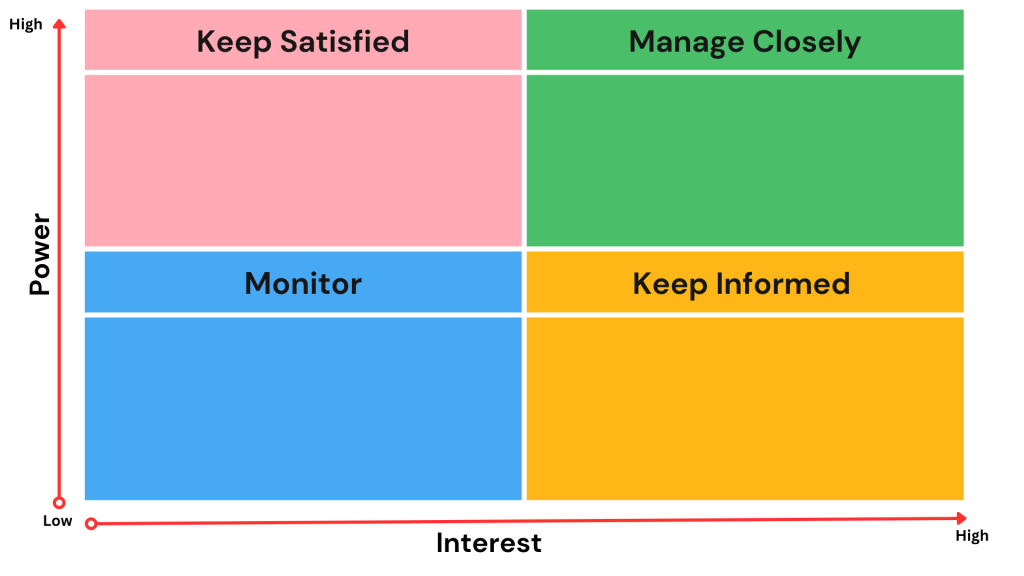Starting a new project can be an exciting journey, but without a clear understanding of those who stand to gain or lose, success may remain elusive.
This is where the pivotal practice of stakeholder analysis comes into play.
In this comprehensive blog post, we explain intricacies of how to do stakeholder analysis by unveiling key steps, methods, and techniques essential for project managers and professionals want to know about their stakeholders.
From identifying key players to prioritizing their interests, we’ll equip you with the knowledge and insights needed to conduct a robust stakeholder analysis that not only mitigates risks but also enhances project outcomes.
So, whether you’re a seasoned project manager seeking to refine your skills or a newcomer eager to grasp the fundamentals, let’s learn together as we decode the art of stakeholder analysis and pave the way for successful project management.
Let’s dive in
Who are stakeholders?
Stakeholders are individuals, groups, or entities that have an interest or concern in a particular project, organization, or system.
These parties can significantly impact or be impacted by the outcomes, decisions, or activities related to the project or entity. Stakeholders are diverse and can include internal and external entities.
What is stakeholder analysis?
Stakeholder analysis is a systematic process of identifying, assessing, and prioritizing the individuals, groups, or entities that can significantly affect or be affected by a project, decision, or organization.
The primary goal of stakeholder analysis is to understand the interests, expectations, and influence of these stakeholders, enabling effective engagement and management throughout the project lifecycle.
Importance of stakeholder analysis
Stakeholder analysis serves as a valuable tool for decision-makers, project managers, and teams, offering insights that have several benefits.
Here are some key benefits of stakeholder analysis.
Informed Decision-Making
Stakeholder analysis provides a comprehensive understanding of the interests, expectations, and potential impact of various individuals or groups involved in a project or organization.
Armed with this knowledge, decision-makers can make informed and strategic decisions that align with stakeholder needs.
By considering diverse perspectives, leaders can navigate complex scenarios, anticipate challenges, and optimize outcomes, ultimately contributing to the overall success and sustainability of the project.
Enhanced Communication
Effective communication is a cornerstone of successful projects, and stakeholder analysis plays a pivotal role in this regard.
By identifying communication preferences, concerns, and expectations of different stakeholders, project managers can tailor their messages to resonate with the intended audience.
This personalized approach fosters transparent and open communication channels, reducing the likelihood of misunderstandings, conflicts, and resistance.
As a result, stakeholders are more likely to be engaged and supportive throughout the project lifecycle.
Mitigation of Risks
Understanding the influence and potential impact of stakeholders allows project managers to proactively identify and address risks.
By anticipating potential challenges or objections from key stakeholders, teams can develop risk mitigation strategies and contingency plans.
This proactive risk management approach minimizes the likelihood of project disruptions, delays, or failures, contributing to a more resilient and adaptive project environment.
Increased Project Success
Ultimately, stakeholder analysis contributes to the overall success of a project by aligning activities with stakeholder expectations and needs.
Engaged and satisfied stakeholders are more likely to support the project, contribute positively, and advocate for its success.
This alignment enhances project buy-in, fosters a collaborative atmosphere, and creates a foundation for successful project implementation.
The benefits extend beyond the project’s completion, as positive stakeholder relationships can influence future opportunities and partnerships.
06 Key Steps of Stakeholder Analysis
Here are the key six steps that help you to do stakeholder analysis.
Step 1: Identification of Stakeholders
The first step involves systematically recognizing and listing all individuals, groups, or entities that can significantly impact or be affected by the project, decision, or organization under consideration.
The identification process lays the foundation for the subsequent steps in stakeholder analysis by ensuring that no relevant party is overlooked.
This step is dynamic, and stakeholders may be added or removed as the project evolves, emphasizing the need for ongoing vigilance and updates to the stakeholder list throughout the project lifecycle.
Identification encompasses both internal and external stakeholders, ranging from employees and management to customers, suppliers, regulatory bodies, and community groups.
Several methods can be employed during this step, including:
Brainstorming Sessions
Engaging key team members, project managers, and experts to generate a comprehensive list based on their knowledge and experience.
Document Review
Examining existing project documentation, organizational charts, and relevant records to identify potential stakeholders.
Surveys and Interviews
Seeking input from individuals involved in or impacted by the project to capture perspectives and uncover stakeholders who might not be immediately apparent.
Step 2: Assessment of Stakeholder Interests and Expectations
This step is integral to effective stakeholder management and ensures that project goals align with the diverse interests of those involved
This step helps to gain insights into what each stakeholder values, expects, and hopes to achieve from the project.
Understanding these interests and expectations helps project managers tailor strategies that align with stakeholder needs and contribute to overall project success.
Key Components of Assessing Stakeholder Interests and Expectations:
Identifying Stakeholder Goals
Determine the specific goals and objectives each stakeholder aims to achieve through their involvement in the project. This could include financial gains, improved processes, social impact, or other relevant outcomes.
Analyzing Concerns and Priorities
Explore any concerns, challenges, or priorities that stakeholders may have regarding the project. Identifying potential conflicts early on allows for proactive resolution and can help build trust.
Assessing Attitudes Toward the Project
Gauge stakeholders’ attitudes and perceptions toward the project. This includes understanding their level of enthusiasm, support, or skepticism, which can influence their engagement.
Determining Communication Preferences
Recognize how stakeholders prefer to receive information and updates. Some may prefer regular meetings, while others may favor written reports or digital communication. Adapting communication channels to suit stakeholders’ preferences enhances engagement.
Considering Cultural and Ethical Factors
Be mindful of cultural nuances and ethical considerations that may impact stakeholder perspectives. Understanding these factors helps in crafting strategies that are sensitive to diverse values and norms.
Methods for Assessing Stakeholder Interests and Expectations
Surveys and Interviews
Conduct surveys or interviews to directly gather information from stakeholders about their interests, expectations, and concerns.
Reviewing Previous Interactions
Examine past interactions, feedback, and historical data to identify patterns in stakeholder behavior and preferences.
Focus Groups
Arrange focus group sessions to facilitate discussions and obtain qualitative insights into stakeholder expectations.
Feedback Mechanisms
Establish ongoing feedback mechanisms to encourage stakeholders to express their thoughts and concerns throughout the project.
Step 3: Evaluation of Stakeholder Influence
This step focuses on understanding the level of impact or influence each stakeholder holds over the project or decision-making processes.
Assessing stakeholder influence is crucial for prioritizing efforts and resources, as it helps project managers identify those who can significantly shape project outcomes.
Key Components of Evaluating Stakeholder Influence:
Identifying Decision-Making Authority
Determine the extent to which each stakeholder is involved in decision-making processes related to the project. Those with decision-making authority often have a higher level of influence.
Analyzing Control over Resources
Assess the control stakeholders have over critical resources, whether they are financial, human, or material. Those with significant resource control often wield greater influence.
Measuring Expertise and Knowledge
Consider the expertise and knowledge that stakeholders bring to the table. Individuals with specialized knowledge or skills may have influence based on their ability to contribute valuable insights.
Assessing Networks and Alliances
Explore the networks and alliances that stakeholders have within and outside the organization. Those with extensive connections may leverage these relationships for increased influence.
Reviewing Past Influence
Examine past instances where stakeholders have influenced project outcomes or decisions. This historical perspective provides insights into their potential impact in the future.
Methods for Evaluating Stakeholder Influence:
Expert Interviews
Consult with subject matter experts or individuals who have a deep understanding of the stakeholders and their potential influence.
Network Analysis
Conduct a network analysis to visualize and assess the connections and relationships between stakeholders. This method highlights influential individuals within the network.
Stakeholder Workshops
Organize workshops or collaborative sessions where stakeholders can openly discuss their roles and influence on the project.
Document Review
Review organizational charts, project documentation, and relevant records to identify roles and positions that signify influence.
Step 4: Prioritisation of Stakeholders
Prioritization of stakeholders in stakeholder analysis refers to the process of ranking or categorizing stakeholders based on their level of importance, influence, and impact on a project or decision.
This step is crucial because not all stakeholders have equal significance, and allocating resources, attention, and efforts effectively requires identifying and focusing on those with the greatest potential to influence or be influenced by the project
This step of stakeholder analysis involves the Prioritization of Stakeholders, and one effective tool for achieving this is the Power-Interest Grid.
This grid is a visual representation that helps project managers assess and prioritize stakeholders based on their level of influence (power) and their level of interest in the project.
Power-Interest Grid
By plotting stakeholders on the Power-Interest Grid, project managers can visually prioritize their efforts, tailor communication strategies, and allocate resources effectively. This approach ensures that key stakeholders receive the attention they deserve, contributing to successful stakeholder engagement and project management.
Power (Vertical Axis)
This represents the degree of influence or decision-making authority a stakeholder possesses. Stakeholders with higher power levels can significantly impact the project’s direction and outcomes.
Interest (Horizontal Axis)
This represents the level of interest or concern a stakeholder has in the project. Stakeholders with high interest are more likely to actively engage and closely monitor project developments.
The grid is divided into four quadrants, each indicating a different category for prioritization:
High Power, High Interest (Manage Closely)
Stakeholders in this quadrant possess both significant power and high interest. They require close management and engagement to ensure their needs are addressed, and their influence is leveraged positively.
High Power, Low Interest (Keep Satisfied)
While these stakeholders wield considerable power, their interest in the project may be limited. It is crucial to keep them satisfied and informed without overwhelming them with excessive details.
Low Power, High Interest (Keep Informed)
Stakeholders in this category have a high level of interest but limited power. They should be kept informed to maintain their support, but extensive management efforts may not be necessary.
Low Power, Low Interest (Monitor)
Stakeholders with low power and low interest may not require extensive management efforts. However, it is essential to monitor their positions and keep a line of communication open in case their stance changes.

Step 5: Development of Stakeholder Profiles
Developing stakeholder profiles is a dynamic process, and these profiles should be regularly revisited and updated to reflect changes in stakeholder interests, influence, or other relevant factors.
These profiles serve as invaluable references for effective communication, conflict resolution, and overall stakeholder management throughout the project lifecycle.
Key Components of Stakeholder Profiles
Stakeholder Identification Information
Basic details such as name, position, role, and contact information to ensure clear identification.
Stakeholder Interests and Expectations:
Level of Influence
A summary of the stakeholder’s level of influence, as determined through the evaluation of decision-making authority, resource control, expertise, and networks.
Communication Preferences
Information on how the stakeholder prefers to receive updates and communications. This can include preferred communication channels, frequency, and format.
Past Interactions and Relationships
Insights from past interactions, collaborations, or conflicts to understand the history and dynamics of the relationship.
Potential Risks and Challenges
Identification of any potential risks or challenges associated with the stakeholder, including areas of disagreement, conflicting interests, or potential resistance.
Alignment with Project Goals
An assessment of the extent to which the stakeholder’s interests align with the overarching goals of the project.
Methods for Developing Stakeholder Profiles:
Surveys and Interviews:
Directly gather information from stakeholders through surveys or interviews to ensure accuracy and depth in profiling.
Feedback Sessions:
Organize feedback sessions where stakeholders can contribute to the development of their own profiles, fostering a sense of ownership.
Documenting Interactions:
Maintain a record of ongoing interactions and feedback to update stakeholder profiles regularly.
Collaborative Workshops:
Conduct collaborative workshops with key stakeholders to collectively develop profiles, ensuring a shared understanding of expectations and responsibilities.
Continuous Monitoring:
Establish mechanisms for continuous monitoring and updates to stakeholder profiles as the project progresses and stakeholder dynamics evolve.
Step 6: Strategic Engagement Planning
Strategic engagement planning is an ongoing process that requires regular review and adjustment.
By proactively managing stakeholder relationships and communication, project managers can enhance support for the project, address challenges promptly, and contribute to overall project success.
This strategic engagement plan ensures that communication is tailored to meet the diverse needs and expectations of stakeholders, ultimately fostering positive relationships and support for the project.
Key Components of Strategic Engagement Planning
Communication Strategies
Tailor communication strategies based on the preferences identified in stakeholder profiles. Consider the frequency, format, and channels of communication that align with each stakeholder’s preferences.
Engagement Objectives
Clearly define the objectives of engaging with each stakeholder. Whether it’s to gain support, gather feedback, or address concerns, understanding the purpose helps guide engagement efforts.
Feedback Mechanisms
Establish effective feedback mechanisms to encourage stakeholders to express their thoughts, concerns, and suggestions throughout the project. This ensures a two-way communication flow.
Conflict Resolution Strategies
Anticipate potential conflicts and develop strategies for resolution. Having predefined approaches for addressing disagreements or challenges helps maintain positive relationships.
Adaptability and Flexibility
Recognize that stakeholder dynamics may change over the course of the project. The plan should be adaptable and flexible, allowing for adjustments based on evolving circumstances.
Resource Allocation
Allocate resources, such as time, budget, and personnel, based on the prioritization of stakeholders. Focus on high-priority stakeholders who have a significant impact on project outcomes.
Methods for Strategic Engagement Planning
Stakeholder Workshops
Conduct workshops or collaborative sessions with key stakeholders to co-create engagement plans, ensuring a shared understanding of expectations.
Communication Plans
Develop detailed communication plans outlining when, how, and what information will be communicated to different stakeholders. This includes regular updates, milestone notifications, and important announcements.
Engagement Calendars
Create engagement calendars that outline scheduled interactions, meetings, and events involving stakeholders. This helps in proactively managing communication and engagement efforts.
Scenario Planning
Anticipate different scenarios and plan for how engagement strategies might need to adapt in response to changes in project circumstances or stakeholder dynamics.
Training and Capacity Building
Consider providing training or capacity-building sessions for stakeholders, especially if the project introduces new concepts or technologies. This ensures that stakeholders are well-informed and confident in their roles.
Stakeholder Analysis Template
A Stakeholder Analysis Template helps organize and document key information about various stakeholders involved in a project or decision-making process. Here’s a suggested template along with explanations for each section:
Project
Project Name:
Date:
1. Stakeholder Identification
Stakeholder Name:
Role/Position:
Contact Information:
2. Stakeholder Interests and Expectations
Goals and Objectives:
Concerns and Priorities:
Attitude Toward the Project:
3. Evaluation of Stakeholder Influence
Decision-Making Authority:
Control Over Resources:
Expertise and Knowledge:
Networks and Alliances:
Past Influence:
4. Stakeholder Profile
Level of Influence (High, Medium, Low):
Level of Interest (High, Medium, Low):
Power-Interest Grid Quadrant:
Communication Preferences:
Risk Factors/Challenges:
Alignment with Project Goals:
5. Strategic Engagement Plan
Communication Strategies:
[Specify channels, frequency, and format]
Engagement Objectives:
[Specify objectives for each stakeholder]
Feedback Mechanisms:
[Specify methods for gathering feedback]
Conflict Resolution Strategies:
[Specify approaches for addressing conflicts]
Adaptability and Flexibility Plan:
[Specify how the plan will adapt to changing circumstances]
Resource Allocation:
[Specify resources allocated for each stakeholder]

Stakeholder Analysis Example
Let’s consider a real-life example of a stakeholder analysis for a community development project aimed at building a new park.
The project involves various stakeholders, including local residents, government officials, environmental organizations, and local businesses. Here’s a simplified stakeholder analysis template for one of the key stakeholders, a local environmental organization:
Stakeholder Analysis Template
Project: Community Park Development
Date: December 15, 2023
1. Stakeholder Identification:
Stakeholder Name: GreenEarth Alliance
Role/Position: Environmental Advocacy Group
Contact Information: [Email, Phone]
2. Stakeholder Interests and Expectations:
Goals and Objectives:
Advocate for sustainable park design and environmentally friendly practices.
Ensure the protection of local flora and fauna during construction.
Concerns and Priorities:
Minimize ecological impact during construction.
Implement water conservation measures within the park.
Attitude Toward the Project:
Supportive of community development with a strong emphasis on environmental responsibility.
3. Evaluation of Stakeholder Influence:
Decision-Making Authority:
Limited direct decision-making authority but influential in community environmental matters.
Control Over Resources:
Moderate control over information and resources related to environmental impact assessments.
Expertise and Knowledge:
High expertise in environmental conservation and impact assessment.
Networks and Alliances:
Strong alliances with other local environmental groups and researchers.
Past Influence:
Successfully influenced previous development projects to incorporate sustainable practices.
4. Stakeholder Profile:
Level of Influence: Medium
Level of Interest: High
Power-Interest Grid Quadrant: Manage Closely
Communication Preferences:
Prefer regular email updates and quarterly meetings.
Risk Factors/Challenges:
Potential conflicts if environmental concerns are not adequately addressed.
Alignment with Project Goals:
Aligned with the project’s broader community development goals but prioritizes environmental sustainability.
5. Strategic Engagement Plan:
Communication Strategies:
Regular email updates on environmental impact assessments and project milestones.
Engagement Objectives:
Seek input on park design elements to ensure alignment with environmental goals.
Feedback Mechanisms:
Quarterly meetings to discuss progress and address concerns.
Conflict Resolution Strategies:
Promptly address environmental concerns through collaborative problem-solving.
Adaptability and Flexibility Plan:
Remain open to adjustments in the project plan based on environmental impact assessments.
Resource Allocation:
Allocate additional resources for environmentally friendly design elements and assessments.
Challenges and Pitfalls in Stakeholder Analysis
Here are the most common challenges and pitfalls managers and professional make in doing stakeholder analysis.
Incomplete Stakeholder Identification
Many a times managers are unable to identify all stakeholders. Failing to identify all relevant stakeholders can lead to oversights and missed opportunities for engagement.
It is always essential to conduct thorough stakeholder identification through collaborative efforts, ensuring diverse perspectives are considered.
Static Stakeholder Analysis
Stakeholder analysis is an ongoing process. Treating stakeholder analysis as a one-time task rather than an ongoing process can result in outdated information.
Managers and professionals need to regularly update stakeholder information to adapt to changing project dynamics and stakeholder relationships.
Assuming Homogeneity Within Stakeholder Groups
It is a mistake on the part of managers and professionals who assume that all individuals and entities are same and they same common interests and concerns. This thinking may lead to oversimplified strategies.
Acknowledge and address diversity within stakeholder groups, tailoring engagement approaches based on individual perspectives.
Neglecting Internal Stakeholders
Sometimes managers and professionals tend to ignore internal stakeholders. They just focus solely on external stakeholders and neglecting internal teams can lead to internal conflicts and hinder project progress.
It is better to include employees, management, and other internal stakeholders in the analysis to foster a collaborative project environment.
Final Words
Mastering how to do stakeholder analysis is integral to the success of any project or organizational endeavor. Through the systematic identification, assessment, and prioritization of stakeholders, project managers gain invaluable insights into the intricate web of interests, influence, and expectations that surround their initiatives. In essence, the art of stakeholder analysis is not merely a one-time exercise but an ongoing process that empowers project leaders to build positive relationships, make informed decisions, and ultimately drive the success of their projects.



